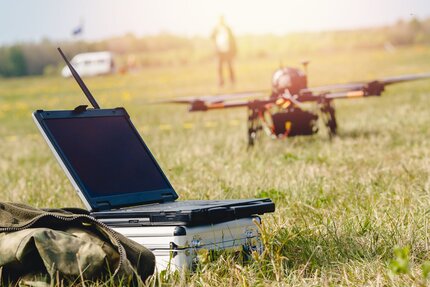Ever since the start of Russia’s invasion of Ukraine, it has been a busy time for the Defense Security Cooperation Agency, the Pentagon arm that oversees foreign military sales.
During the first seven months of 2022, the agency facilitated 44 such deals, up from 25, 43 and 40 cases in the same period of the previous three years.
And it’s a torrid time for the defense companies themselves. Kathy Warden, CEO of defense giant Northrop, said the defense industry is at a crucial turning point: “We’ve seen a fundamental shift in global commitment of resources for defense and national security, particularly in Europe.”
Among the defense companies whose intake of orders from overseas has soared is a relative minnow in the industry: AeroVironment (AVAV). And much of this is due to the conflict in Ukraine.

AeroVironment and Killer Drones
AeroVironment was founded in 1971, but since then, it has largely flown under the radar, all the while developing an expertise in small robotic aviation systems.
Before the war in Ukraine, the company was perhaps best known by the public for co-developing the robotic helicopter that operates on Mars, Ingenuity. Attached to the belly of the Perseverance rover, the small aircraft arrived on the red planet in February 2021. Ingenuity has made the first powered, controlled flights by an aircraft on a planet other than Earth, starting April 19, 2021.
Within the defense industry, though, AeroVironment was best-known for its unmanned drones. Earlier models of its Puma and Raven drones, for instance, were deployed during the first Gulf war in the 1990s.
Moving ahead to today and the Special Operations Forces of the Ukrainian army often speaks of a “modern kamikaze drone equipped with powerful explosives” inflicting “irreparable losses to the enemy.”
The killer drone is AeroVironment’s Switchblade drone. Since Russia’s invasion, the Pentagon has sent more than 700 Switchblade drones, armed with warheads, to Ukraine.
With the Switchblade, soldiers have a system that provides both surveillance and munitions in a single package. AeroVironment delivered the first one to the Pentagon, which has since procured thousands, in 2010. The systems sent to Ukraine are from U.S. inventory.
The armed drone comes in two versions—the Switchblade 300, and a larger, newer version dubbed the Switchblade 600. Electrically powered and slower than rockets, the 600 has low radar, heat, and noise signatures. As company CEO Wahid Nawabi said, “You cannot see it, you cannot hear it.”
Switchblades are shot out of a tube, and the advanced 600 version can stay airborne for at least 40 minutes. Cruising at 70 miles per hour, the vehicle can travel more than 55 miles before losing power. After locking on to a target, it completes its mission and explodes. Should a target prove incorrect, the drone can be waved off until the last moment.
AeroVironment’s Future
As you can imagine, success on the Ukrainian battlefield is boosting international demand for all of AeroVironment’s armed drones. Nawabi said: “I believe that Switchblade is going through the same sort of growth trajectory” as the company’s more established systems.
The Pentagon had already permitted AeroVironment to export its unarmed Raven and Puma drones to 50 countries, and the company generates 40% of its roughly $450 million in annual revenue from international sales.
However, the Pentagon did not clear Switchblade systems for export until last month, when it approved sales to 20 countries. Most of these countries are in Europe, including the Baltic countries that have the Russian threat right on their doorstep. As Louie DiPalma, an analyst at William Blair, explained to the Financial Times: “Investors in AeroVironment had been waiting for many years for AeroVironment to be given U.S. State Department approval to export the Switchblade.”
AeroVironment is much more than killer drones, though.
Its Small Unmanned Aircraft Systems division is a global leader, with a product line generating $178 million—40% of its revenue in fiscal 2022. This segment has a strong international position, with 47% of revenue in the 2021 fiscal year coming from international customers. More than 50 allied nations have purchased such products. And these aircraft make up a majority share of all unmanned aircraft in U.S Department of Defense (DOD) inventory.
In its Medium Unmanned Aircraft Systems division, AeroVironment acquired Arcturus UAV, a leading provider of unmanned aircraft systems. Fiscal year 2022 revenue comes in at $93 million, or 21% of company revenue. It offers a significant market opportunity, with the $1 billion market today expected to grow to $3 billion by 2030.
And of course, there is the Tactical Missile Systems division, whose product line consists of the Switchblade and the Blackwing, a submarine-launched killer drone. The growth here has just begun, with fiscal year 2022 revenue of $76 million, or 17% of total company revenue.
AeroVironment generated revenues of $445.7 million in the 12 months ending on April 30, with almost a fifth of that coming from the tactical missile systems unit that makes the Switchblade. The company is expecting revenues of $490 million to $520 million for the 2023 fiscal year, ending April 30.
The company’s Nasdaq-listed shares are up over 50% since the start of the war in Ukraine. But at $102 a share, its stock price is still well below a peak of $137.94 reached in February 2021 when Cathie Wood’s Ark investment funds acquired a large stake.
That holding by ARK is the only negative I see, as Wood may be forced to liquidate AeroVironment during a nasty market downturn.
But thanks to its success on the Ukrainian battlefield, AeroVironment’s long-term outlook is stronger than ever. It’s a buy anywhere in the $100 range.





